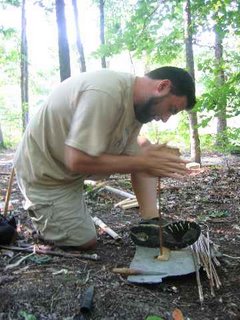 Looks like we had another successful weekend with Earth Connection's FIRE PALOOZA.
Looks like we had another successful weekend with Earth Connection's FIRE PALOOZA.We had Fires all around us... from hand drills (including w/thumb assist), bow drills (using differing wood for fire boards and spindles), pump drills, fire plow, flint and steel... shall I go on?
There was success in every fire method. We even had a few surprises as Tim showed his soon to be famous (and patented) one armed technique and Hue got a fire with a charred Oak fire board.
The Fire Plow Boys make their debut at FIRE PALOOZA
(Five fire plow fires successfully made in less than 20 minutes... Tim got one too!)

Fire Making Process
Carbonization
Spindle recipication motion on fire board creates friction heat. The thermal decomposition starts in the range 120-200 degrees Celsius is caused by friction heat and results in wood mass loss, moisture content release and the non-combustible degradates release into the combustion space. At 200-280 degrees Celsius, mainly endothermic reactions occur while the heat energy of the ignition source is taken up by surrounding materials. At 280-500 degrees Celsius, the exothermic reactions of decomposition products are progressively accelerating as the primary process, while carbonization occurs. In this temperature range, sustaining combustion has already developed.
Glowing Ignition
The carbon in the char combines with oxygen producing heat, a much slower reaction than flaming ignition. Glowing ignition is self-sustaining until all carbon fuel is used up. Glowing ignition is about 500 degrees F (260 degrees C) for wood. At tempuratures exceeding 500 degrees F (260 degrees C), the wood char forms residues. During its additional glowing, ash containing solid, inorganic material is produced, and the process has come to an end
Flaming Ignition
The coal is introduced to tinder and more oxygen is added. This produces the gaseous volitile organic compounds needed for flaming ignition or combustion. When the volatile gases are hot enough (about 500-617 degrees F (260-325 degrees C) for wood), the compound molecules break apart, and the atoms recombine with the oxygen to form water, carbon dioxide, soot and other products.

1 comment:
This is by far the best class that I have ever taken to date. Tim and Hue, you guys did a great job. This class both boosted my confidence and gave me new insights into fire making. The break down of the physical and chemical reactions that occur during this process gave me new insight into the process. These processes are exactly the same for all techniques and based off this information you can create new techniques on your own. The new one arm technique was amazing because we all know that in a survival situation you may not be as able bodied as you would like to be.
Finally, the plant and materials walk that we did afterwards was very helpful. I am now seeing plants everywhere that are good materials. Yesterday I picked up the straightest Horseweed spindle. It may replace Mullein as my favorite for Hand Drills.
Blake
Post a Comment